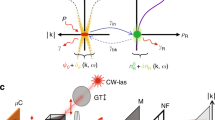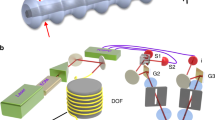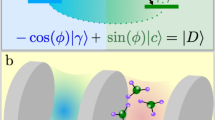Abstract
Over the past decade, exciton-polaritons in semiconductor microcavities have revealed themselves as one of the richest realizations of a light-based quantum fluid1, subject to fascinating new physics and potential applications2,3,4,5,6. For instance, in the regime of large two-body interactions, polaritons can be used to manipulate the quantum properties of a light field7,8,9. In this work, we report on the emergence of quantum correlations in laser light transmitted through a fibre-cavity polariton system. We observe a dispersive shape of the autocorrelation function around the polariton resonance that indicates the onset of this regime. The weak amplitude of these correlations indicates a state that still remains far from a low-photon-number state. Nonetheless, given the underlying physical mechanism7, our work opens up the prospect of eventually using polaritons to turn laser light into single photons.
This is a preview of subscription content, access via your institution
Access options
Access Nature and 54 other Nature Portfolio journals
Get Nature+, our best-value online-access subscription
$29.99 / 30 days
cancel any time
Subscribe to this journal
Receive 12 print issues and online access
$259.00 per year
only $21.58 per issue
Buy this article
- Purchase on Springer Link
- Instant access to full article PDF
Prices may be subject to local taxes which are calculated during checkout




Similar content being viewed by others
Data availability
All data presented in this work are available on request from the authors.
References
Carusotto, I. & Ciuti, C. Quantum fluids of light. Rev. Mod. Phys. 85, 299–366 (2013).
Berloff, N. G. et al. Realizing the classical XY Hamiltonian in polariton simulators. Nat. Mater. 16, 1120–1126 (2017).
Jacqmin, T. et al. Direct observation of Dirac cones and a flatband in a honeycomb lattice for polaritons. Phys. Rev. Lett. 112, 116402 (2014).
Baboux, F. et al. Bosonic condensation and disorder-induced localization in a flat band. Phys. Rev. Lett. 116, 066402 (2016).
Dagvadorj, G. et al. Nonequilibrium phase transition in a two-dimensional driven open quantum system. Phys. Rev. X 5, 041028 (2015).
Klembt, S., Stepanov, P., Klein, T., Minguzzi, A. & Richard, M. Thermal decoherence of a nonequilibrium polariton quantum fluid. Phys. Rev. Lett. 120, 035301 (2018).
Verger, A., Ciuti, C. & Carusotto, I. Polariton quantum blockade in a photonic dot. Phys. Rev. B 73, 193306 (2006).
Boulier, T. et al. Polariton-generated intensity squeezing in semiconductor micropillars. Nat. Commun. 5, 3260 (2014).
Cuevas, Á. et al. First observation of the quantized exciton-polariton field and effect of interactions on a single polariton. Sci. Adv. 4, eaao6814 (2018).
Savasta, S., Stefano, O. D., Savona, V. & Langbein, W. Quantum complementarity of microcavity polaritons. Phys. Rev. Lett. 94, 246401 (2005).
Amo, A. et al. Exciton-polariton spin switches. Nat. Photon. 4, 361–366 (2010).
Birnbaum, K. M. et al. Photon blockade in an optical cavity with one trapped atom. Nature 436, 87–90 (2005).
Lang, C. et al. Observation of resonant photon blockade at microwave frequencies using correlation function measurements. Phys. Rev. Lett. 106, 243601 (2011).
Liebisch, T. C., Reinhard, A., Berman, P. R. & Raithel, G. Atom counting statistics in ensembles of interacting Rydberg atoms. Phys. Rev. Lett. 95, 253002 (2005).
Jia, N. et al. A strongly interacting polaritonic quantum dot. Nat. Phys. 14, 550–554 (2018).
Faraon, A. et al. Coherent generation of non-classical light on a chip via photon-induced tunnelling and blockade. Nat. Phys. 4, 859–863 (2008).
Reinhard, A. et al. Strongly correlated photons on a chip. Nat. Photon. 6, 93–96 (2012).
Walker, P. M. et al. Dark solitons in high velocity waveguide polariton fluids. Phys. Rev. Lett. 119, 097403 (2017).
Deveaud, B. et al. Excitonic effects in the luminescence of quantum wells. Chem. Phys. 318, 104–117 (2005).
Besga, B. et al. Polariton boxes in a tunable fiber cavity. Phys. Rev. Appl. 3, 014008 (2015).
Reitzenstein, S. et al. AlAs/GaAs micropillar cavities with quality factors exceeding 150.000. Appl. Phys. Lett. 90, 251109 (2007).
Wood, A., Vidal, X., Muñoz-Matutano, G. & Volz, T. Non-invasive zero delay calibration of Hanbury Brown and Twiss interferometer. Measurement https://doi.org/10.1016/j.measurement.2019.01.079 (2019).
Amo, A. et al. Superfluidity of polaritons in semiconductor microcavities. Nat. Phys. 5, 805–810 (2009).
Ferrier, L. et al. Interactions in confined polariton condensates. Phys. Rev. Lett. 106, 126401 (2011).
Delteil, A. et al. Towards polariton blockade of confined exciton-polaritons. Nat. Mater. https://doi.org/10.1038/s41563-019-0282-y (2019).
Casteels, W., Rota, R., Storme, F. & Ciuti, C. Probing photon correlations in the dark sites of geometrically frustrated cavity lattices. Phys. Rev. A 93, 043833 (2016).
Carusotto, I. et al. Fermionized photons in an array of driven dissipative nonlinear cavities. Phys. Rev. Lett. 103, 033601 (2009).
Miller, D. A. B. Are optical transistors the logical next step?. Nat. Photon. 4, 3–5 (2010).
Noh, C. & Angelakis, D. G. Quantum simulations and many-body physics with light. Rep. Prog. Phys. 80, 016401 (2017).
Hadfield, R. H. Single-photon detectors for optical quantum information applications. Nat. Photon. 3, 696–705 (2009).
Acknowledgements
We thank S. Martin and D. Taylor from the Commonwealth Scientific and Industrial Research Organisation (Lindfield – New South Wales) for their technical support. This work was funded by the Australian Research Council Centre of Excellence for Engineered Quantum Systems (CE110001013 and CE170100009). A.L., J.B., A.A. and M.R. acknowledge support from the French Agence National de la Recherche (contract no. ANR-16-CE30-0021).
Author information
Authors and Affiliations
Contributions
G.M.-M. and A.W. carried out the spectroscopy and photon correlation experiments and analysed the data. M.J., with the help of B.Q.B., implemented the master equation model and contributed to the analysis of the data. G.M.-M., A.W. and M.J. have equally contributed to this research. X.V. built the spectroscopy set-up. A.R. and B.B. built the cavity microscope and designed the laser machining system for making the fibre cavities. A.L., J.B. and A.A. provided the QW sample and discussed the underlying polariton physics. G.N. carried out the finite-elements simulation of the cavity mode. M.R. and T.V. conceived the central idea of the work and related experiments, supervised the experimental work and contributed to discussions. The manuscript was written by G.M.-M., M.J., M.R. and T.V. with varying contributions from all other authors.
Corresponding authors
Ethics declarations
Competing interests
The authors declare no competing interests.
Additional information
Publisher’s note: Springer Nature remains neutral with regard to jurisdictional claims in published maps and institutional affiliations.
Supplementary information
Supplementary Information
Supplementary Sections 1–7, Supplementary Figures 1–11, Supplementary References 1–14
Rights and permissions
About this article
Cite this article
Muñoz-Matutano, G., Wood, A., Johnsson, M. et al. Emergence of quantum correlations from interacting fibre-cavity polaritons. Nature Mater 18, 213–218 (2019). https://doi.org/10.1038/s41563-019-0281-z
Received:
Accepted:
Published:
Issue Date:
DOI: https://doi.org/10.1038/s41563-019-0281-z
This article is cited by
-
Nonlinear Rydberg exciton-polaritons in Cu2O microcavities
Light: Science & Applications (2024)
-
Qubit gate operations in elliptically trapped polariton condensates
Scientific Reports (2024)
-
Deterministic entangling gates with nonlinear quantum photonic interferometers
Communications Physics (2024)
-
Local tuning of Rydberg exciton energies in nanofabricated Cu2O pillars
Communications Materials (2024)
-
Light–matter interactions in quantum nanophotonic devices
Nature Reviews Physics (2024)



